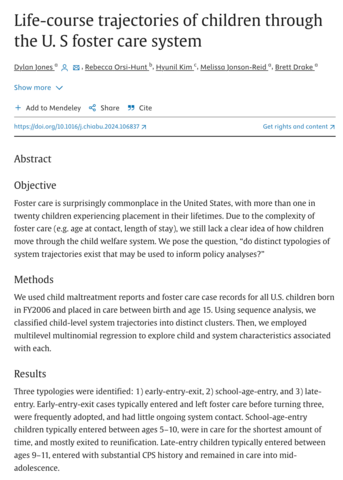Objective:
Foster care is surprisingly commonplace in the United States, with more than one in twenty children experiencing placement in their lifetimes. Due to the complexity of foster care (e.g. age at contact, length of stay), we still lack a clear idea of how children move through the child welfare system. The authors pose the question, “do distinct typologies of system trajectories exist that may be used to inform policy analyses?”
Methods:
The authors used child maltreatment reports and foster care case records for all U.S. children born in FY2006 and placed in care between birth and age 15. Using sequence analysis, they classified child-level system trajectories into distinct clusters. Then, they employed multilevel multinomial regression to explore child and system characteristics associated with each.
Results:
Three typologies were identified: 1) early-entry-exit, 2) school-age-entry, and 3) late-entry. Early-entry-exit cases typically entered and left foster care before turning three, were frequently adopted, and had little ongoing system contact. School-age-entry children typically entered between ages 5–10, were in care for the shortest amount of time, and mostly exited to reunification. Late-entry children typically entered between ages 9–11, entered with substantial CPS history and remained in care into mid-adolescence.
Conclusions:
Their findings provide the first description of foster care trajectories in the US. Both practice and policy formulation can benefit from these empirically supported descriptions. Using such trajectory typologies, researchers can now explore how trajectories may predict wellbeing outcomes. The authors discuss how the differences among the typologies may inform identification of service needs and outcomes.

